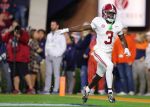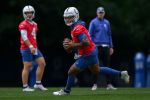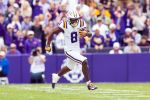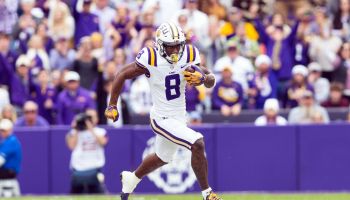INDIANAPOLIS – In getting more than a decade older at quarterback, the Colts are really changing the type of guy now under center.
First, let’s take a look at the 2019 numbers of Philip Rivers (16 starts) and Jacoby Brissett (15 starts):
–Rivers: 390-of-591 (66.0 percent), 4,615 yards, 23 TDs, 20 INTs, 7.8 yards per attempt, 88.5 rating
–Brissett: 272-of-447 (60.9 percent), 2,942 yards, 18 TDs, 6 INTs, 6.6 yards per attempt, 88.0 rating
Over the weekend, Frank Reich explained to Colts.com what Rivers is going to bring on the field:
“As a player, he has unique abilities,” Reich said of Rivers. “You’re gonna see a good mix of vertical pass game with a get-it-out-of-your-hand-quick (ability). He knows how to work the crowd, work the game, much like a Peyton Manning did in that no-huddle offense. That was some of our experience together when we worked together before.”
So, where do we see some other differences in Rivers and Brissett?
Quicker Rhythm
As Reich said, do expect the ball to come out quicker in 2020.
Rivers ranked 5th in the NFL last year in getting the ball out on an average of 2.63 seconds. That compared to Brissett ranking 38th (second longest of all qualifying QBs) at 2.93 seconds.
While .3 seconds might not seem like it’s a long time, that’s a huge difference when picturing NFL speed on an every down basis.
Limited Mobility
Easily the biggest knock on Rivers is his lack of ability to move in, and out of the pocket.
The oft-script plays won’t be as aplenty with Rivers under center, which means even more pressure is on the pass protection of the Colts in 2020. The unit needs to protect like its 2018 again, when it was the best group in the NFL.
Interestingly enough though, Rivers actually had a smaller sack percentage (5.4%) than Brissett (5.7%) last season. Of course, a big reason for that comes from the note above, in how much faster the ball comes out of Rivers’ right hand.
Still, the ability for the Indy offensive line to hold up, and stay healthy, will be a major storyline in 2020.
Cognitive Ability
This is a big deal for Frank Reich.
And Reich considers Rivers one of the smartest players he’s ever been around.
While the Colts were pleased with a lot of things Brissett handled pre-snap and at the line of scrimmage, they wanted him to process things a little quicker in knowing where to go with the football earlier in the play.
Rivers playing in this offensive system since 2013 was a very attractive element into this marriage happening.
Less Arm Strength
Even though the big play numbers would say otherwise, I do not think there’s any doubt that Brissett carries the stronger arm of the two.
The Chargers had 57 passing plays of at least 20 yards last year, while the Colts had 38. Rivers had an ‘average intended air yards’ of 8.6 last season, with Brissett at 7.9. Without a doubt, Rivers benefitted from having some bigger body wideouts coming down with key 50/50 balls to enhance the big play potential.
But still, there are some questions about the pure arm strength of the 38-year-old Rivers, although he did rank high in the NFL last year in attempts down the field.
That attribute of Brissett though wasn’t used to its fullest in 2019, and the Colts saw the ramifications of that with their quiet passing game.
More Accuracy
Easily the most consistent (and best) aspect of Rivers’ time playing under Frank Reich was the high completion percentage.
And that part of the passing offense was a major issue for the Colts last year.
Per Next Gen Stats, Rivers had a plus 1.7 expected completion percentage last year (8th in the NFL), and Brissett’s was minus 4 (36th in the NFL).
With Rivers getting the ball out so quick, he’s going to be looking for the higher percentage opportunities for completions, and then rely on pass catchers to create things after the catch.
Having said that, Rivers certainly benefitted from a much better, more dynamic pass catching group, something that is not set in stone with the Colts.
Different Decision Making
Even though deeper analytics don’t show a huge difference in the aggressiveness of Rivers or Brissett from last year, the turnover numbers are eye-popping.
Rivers tossed 20 picks (3.4 interception percentage) compared to 6 INTs for Brissett (1.3 interception percentage).
The decision-making, and the willingness to force the football, particularly vertically, is definitely going to change in 2020, as Reich pointed out.
And that brings pros (more big plays), and cons (more turnovers) to the situation.












